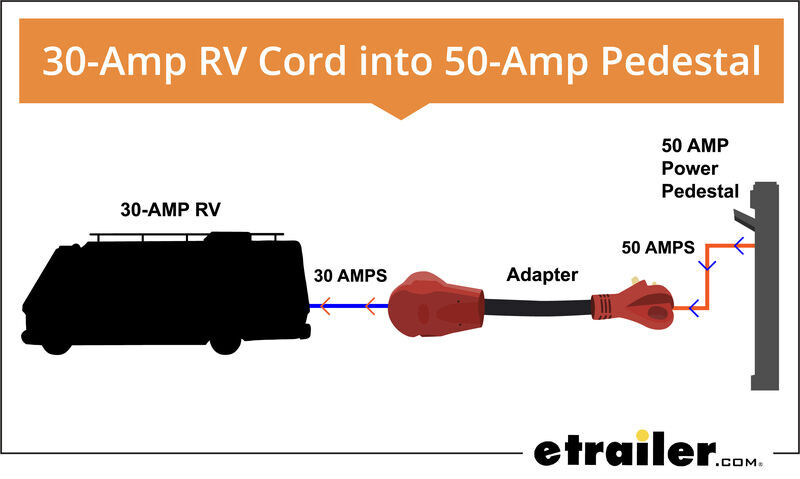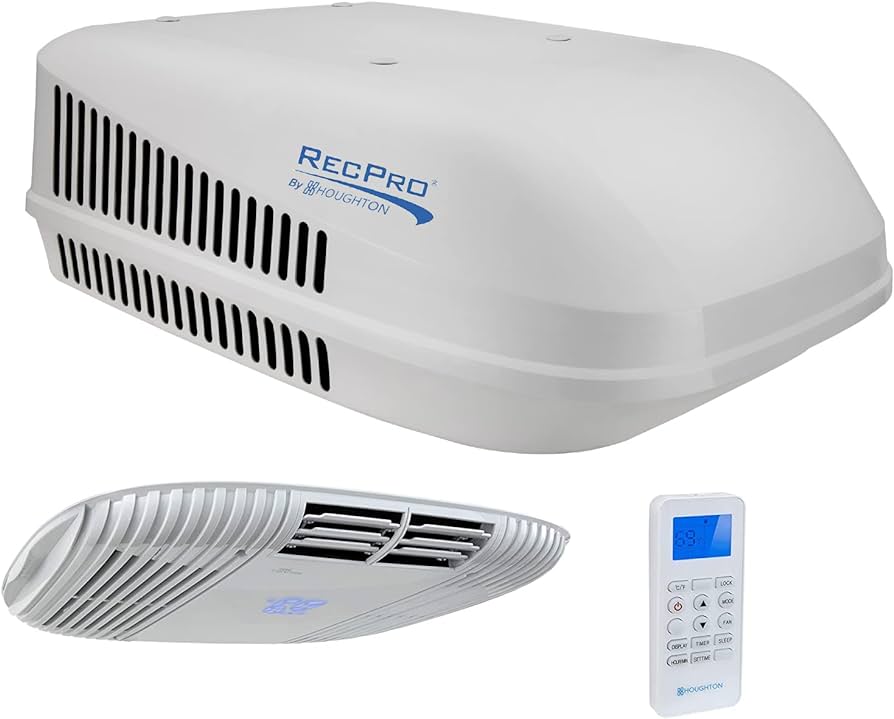Yes, you can run an RV AC on a 30-amp service. Most RV air conditioning units are designed to operate within this capacity.
Traveling in an RV brings the comfort of home on the road, and maintaining a cool interior is essential, especially during warmer months. The electrical system in your RV is a critical factor in determining what appliances you can run simultaneously.
A standard RV air conditioner typically requires around 13-16 amps when running. With a 30 amp service, which is common in many RVs, you have enough power to operate your AC unit along with a few other appliances. It’s crucial to manage your power usage effectively to avoid tripping the circuit breaker. Understanding the power requirements of your RV’s AC and other appliances will ensure a comfortable and hassle-free journey. Always check the specifications of your particular AC model and consult your RV’s manual for the best power management practices.
Rv Ac And Power Essentials
Exploring the vast outdoors in an RV brings comfort and adventure to your doorstep. Understanding your RV’s power requirements ensures a smooth journey. The heart of this comfort, especially in warm climates, is your RV’s air conditioning (AC) system. It’s crucial to know if your RV’s AC can run on a standard 30-amp power supply.
The Role Of Amperage In Rvs
Amperage, or current, is a key factor in your RV’s electrical system. It determines how many appliances you can run simultaneously. Most RVs come with either a 30 amp or a 50 amp power connection. A 30-amp service provides up to 3,600 watts of power, while a 50-amp service offers up to 12,000 watts. This difference affects your RV’s AC operation.
- 30 amp service is suitable for smaller RVs.
- 50 amp service can support multiple AC units in larger RVs.
Types Of RV AC Units
RV AC units come in various sizes and cooling capacities, measured in BTUs (British Thermal Units). The type of AC unit in your RV will determine if it can run on a 30-amp service.
AC Unit Type Cooling Capacity (BTUs) Typical Amperage Rooftop AC 13,500 – 15,000 12 – 16 amps Portable AC 5,000 – 10,000 5 – 10 amps Under-bench AC 7,000 – 8,000 6 – 8 amps Most single rooftop AC units can run comfortably on a 30 amp service. However, running additional appliances simultaneously may require careful power management.
30 Amp Service For Rvs
Traveling in an RV brings the comfort of home on the road. One key to comfort is the electrical system. Most RVs come with either a 30 amp or a 50 amp service. The 30 amp service is quite common and offers a decent amount of power for your RV’s appliances and devices, including the air conditioning unit. Understanding the specifics of a 30 amp service is crucial for a safe and enjoyable trip.
Characteristics Of A 30 Amp Service
A 30 amp service for an RV includes several key features. Here’s what sets it apart:
- Single 120-volt electrical phase
- Maximum of 3,600 watts of power
- Designed for smaller to medium-sized RVs
This service uses a three-prong plug, with one hot wire, one neutral wire, and one ground wire. It’s enough to power basic RV necessities, including the AC unit, albeit with some power management.
Limitations And Considerations
Running an RV air conditioner on a 30 amp service requires awareness of its limitations. Here’s what to consider:
- Power Capacity Max 3,600 watts means careful appliance use Single AC Unit
- Typically supports one AC unit at a time Appliance Management
- Turn off other high-wattage devices when AC is running For a successful trip with all the comforts,
- keep an eye on your total power usage.
- Make sure not to overload the system to prevent tripping the breaker.
Feasibility Of AC on 30 Amp Power
Running an RV air conditioner on 30 amps is possible, but it’s essential to understand your RV’s power demands. Most RVs come equipped with a 30 amp power system, designed to handle a certain amount of electrical load. A standard RV AC unit can draw anywhere from 12 to 16 amps, depending on its BTU capacity. Therefore, you can run your RV’s AC on 30 amps, but it’s vital to manage additional appliances carefully to avoid tripping the circuit.
Steps To Safely Run Ac
- Check Your RV’s Electrical System: Ensure it’s rated for 30 amp service and your AC’s amp draw is within limits.
- Power Management is Key: Prioritize appliances. Run the AC when usage of other heavy appliances is low.
- Inspect Your AC Unit: Verify that it’s in good condition. Regular maintenance reduces power consumption.
- Upgrade If Necessary: Consider a soft start kit for your AC. This device can reduce the initial power surge.
- Use a Surge Protector: Protect your RV’s electrical system from unexpected power surges.
- Monitor Power Consumption: Use an RV energy management system or monitor to keep an eye on your power usage.
By following these steps, you can enjoy a cool and comfortable RV experience, even with the limitations of a 30 amp power supply. Remember, smart energy management is the key to a successful trip.
Energy Management For Campers
Energy Management for Campers is crucial when enjoying the great outdoors in an RV. Balancing comfort with the limitations of a 30-amp hookup can be a challenge. Smart energy use ensures your RV AC and other appliances run smoothly. Let’s explore how to keep everything powered up without tripping a breaker.
Prioritizing Appliances
To manage your RV’s energy, know what’s important. Your RV AC might be a must-have on hot days. But other appliances might need to wait. List your appliances by need. Use them one at a time if they draw a lot of power.
- AC units often top the list in summer.
- Microwaves and hairdryers use high energy too.
- Chargers and lights usually have lower energy needs.
Use a schedule to run high-demand appliances separately. This prevents overloads on your 30-amp service.
Monitoring Power Usage
Keep an eye on your energy use. Modern RVs may have built-in monitors. If not, add a power meter. This helps you stay within your 30-amp limit.
Appliance Average Power Usage RV AC 12-16 amps Microwave 8-13 amps Hairdryer 5-12 amps Lights 1-2 amps By tracking usage, you can adjust as needed. Remember, your RV AC can use half your power alone. Turn off other appliances when the AC is running. This simple step can keep your camping trip comfortable and stress-free.
Tips To Optimize AC Usage
Optimizing your RV AC on a 30 amp service is key to comfort and efficiency. Here are practical tips to maximize your AC’s performance without overloading the system.
Peak Hours Operation
Using your AC smartly during peak hours can save energy and reduce strain on your RV’s electrical system. Peak hours usually occur in the afternoon when temperatures and electricity demand are highest. Try to limit heavy AC use during these times. Instead, cool your RV in the morning or late evening. This strategy not only preserves your system but also can help avoid tripping the campground’s electrical supply.
Thermostat Settings For Efficiency
Setting your thermostat correctly can lead to significant energy savings. Here’s how to set your thermostat for optimal efficiency:
- Set a reasonable temperature: 78 degrees Fahrenheit is ideal when you are inside the RV.
- Increase temperature when away: If you leave the RV, set the thermostat to 80 degrees to reduce energy use.
This method keeps your RV comfortable without overworking the AC system.
Remember, managing your RV’s AC use is crucial for a smooth and enjoyable camping experience, especially when connected to a 30-amp service. These tips ensure you stay cool and your system runs efficiently.

Credit: www.doityourself.com
Alternative Cooling Solutions
Staying cool in your RV doesn’t always mean relying on AC, especially when you’re hooked up to just 30 amps. Alternative cooling solutions can offer relief without overtaxing your system. Let’s explore some efficient ways to keep the temperature down without the heavy energy draw of traditional air conditioning.
Using Fans And Ventilation
Moving air can make a big difference in your comfort level. Fans are a great ally in combating heat.
- Ceiling fans: These help circulate air throughout your RV.
- Window fans: They pull in cooler outside air and push out the warm air.
- Battery-operated fans: Perfect for spots without outlets.
Remember to open windows in the evening to allow cooler air in. During the day, keep blinds closed to block out the sun.
Portable AC units And Coolers
When the built-in AC is too much for your 30 amp supply, consider a portable unit.
- Portable air conditioners: They can cool small areas and use less power.
- Evaporative coolers: These are best in dry climates and consume minimal electricity.
Some coolers can even run on 12V power, perfect for dry camping. Always check the power requirements before making a purchase to ensure compatibility with your RV’s electrical system.
Maintenance To Enhance Ac Performance
Maintenance to Enhance AC Performance is crucial for the longevity of your RV air conditioning system, especially when operating on a 30 Amp power source. Proper care ensures efficient cooling and reduces the risk of overloading the electrical system. Implementing a routine maintenance schedule can significantly improve the performance of your AC unit. Here are essential tips to keep your AC in top shape.
Regular Ac Check-ups
Just like your car, your RV’s AC needs regular check-ups. These check-ups help spot issues before they become costly repairs. Make sure to:
- Inspect the AC unit for any visible damage or wear.
- Listen for unusual noises that could indicate a problem.
- Verify that all connections are secure and intact.
- Check refrigerant levels to ensure optimal cooling.
Cleaning Filters And Coils
Clean filters and coils are vital for airflow and efficiency. Follow these steps:
- Turn off the AC to avoid any electrical hazards.
- Remove the filters and wash or replace them if they are dirty.
- Clean the coils with a soft brush or special coil cleaner.
- Allow everything to dry completely before reassembling.
By maintaining your RV’s AC unit, you’ll enjoy cool, comfortable travels without straining your 30 Amp system.

Credit: m.youtube.com
Upgrade Options For Heavy Power Users
Many RV owners find the standard 30 amp service limiting. This section explores upgrade options for those needing more power.
Switching To 50 Amp Service
Upgrading to 50 amp service is a popular choice. This service allows you to run multiple high-power devices simultaneously. Consider this upgrade if you frequently use air conditioners, microwaves, or heaters. The upgrade involves replacing your RV’s power cord and circuit panel. A certified electrician should perform these changes to ensure safety and compliance with electrical codes.
Solar Panels And Generators
Solar panels and generators provide additional power sources. They are perfect for those who enjoy remote camping or have high energy needs. Here’s how they help:
- Solar panels convert sunlight into electricity. They reduce generator usage, saving fuel and reducing noise.
- Generators are useful for backup power. They are essential when solar power is insufficient.
Consider both options to ensure a constant power supply. Combining solar panels with a generator creates a reliable, efficient energy system. This combination is especially useful in varying weather conditions.

Credit: www.etrailer.com
Conclusion
Running your RV AC on a 30 amp connection is indeed possible with the right setup. Ensure your unit’s compatibility and manage power usage wisely to avoid tripping breakers. With careful planning, you can enjoy cool comfort in your RV, even with limited amp capacity.
Always prioritize safety in your electrical arrangements.

